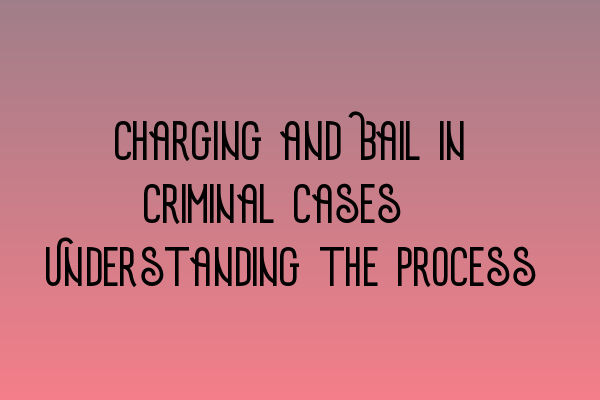Charging and Bail in Criminal Cases: Understanding the Process
At SQE Criminal Law & Practice Law UK, we believe it is crucial for aspiring solicitors to have a clear understanding of the process of charging and bail in criminal cases. This knowledge is essential for successfully representing clients and achieving favorable outcomes. In this blog post, we will guide you through the process, breaking it down into easy-to-understand steps. If you require further guidance, our SQE 1 and SQE 2 preparation courses are designed to equip you with the necessary skills and knowledge for your legal career.
1. Charging in Criminal Cases
Charging is the formal process by which a suspect is accused of committing a criminal offense. It involves the gathering of evidence by the police, followed by a review of the evidence by the Crown Prosecution Service (CPS). The CPS examines the evidence to determine if there is sufficient evidence to charge the suspect and proceed with a prosecution. To learn more about the legal concepts and principles involved in charging, you can refer to our SQE 1 preparation courses.
2. Bail in Criminal Cases
Bail is the process by which a defendant is released from custody pending trial. It serves to balance the rights of the accused with the need to protect the public and ensure the defendant’s attendance at court. Understanding the criteria for granting or refusing bail is crucial for solicitors representing clients in criminal cases. Our SQE 2 preparation courses provide comprehensive training on bail applications and the relevant legal principles.
3. The Process of Charging and Bail
The process of charging and bail can be summarized in the following steps:
- Arrest: The police arrest a suspect based on reasonable grounds to believe that they have committed an offense.
- Investigation: The police conduct an investigation to gather evidence and build a case against the suspect.
- Evidence Review: The CPS reviews the evidence provided by the police to determine if there is sufficient evidence to charge the suspect.
- Charge: If the CPS determines that there is sufficient evidence, the suspect is formally charged with the offense.
- Bail Application: The defendant, through their legal representative, can apply for bail, either at the police station or during the first court appearance.
- Bail Hearing: The court considers various factors, such as the seriousness of the offense, the defendant’s criminal record, and the risk of flight, in deciding whether to grant or refuse bail.
- Bail Decision: The court can grant bail with conditions or remand the defendant in custody until trial.
It is important for solicitors to stay updated with the latest SRA SQE exam dates to effectively plan their preparation. You can find the relevant information on our website: SRA SQE Exam Dates.
By understanding the process of charging and bail in criminal cases, aspiring solicitors can provide effective representation to their clients and navigate the legal system with confidence. If you want to further enhance your knowledge, we offer SQE 1 practice exam questions and SQE 1 practice mocks FLK1 FLK2.
At SQE Criminal Law & Practice Law UK, we are committed to empowering future solicitors with the skills and knowledge they need to succeed in their legal careers. Take advantage of our SQE 1 and SQE 2 preparation courses today.
